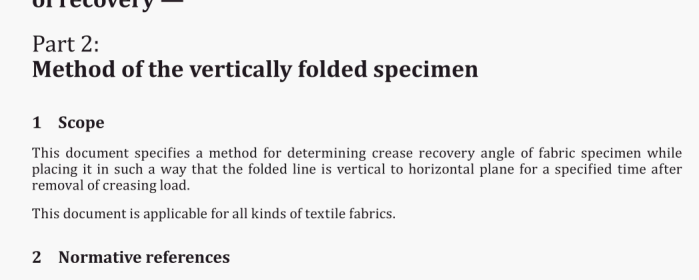BS EN ISO 2313-2:2021 Textiles一Determination of the recovery from creasing of a folded specimen of fabric by measuring the angle of recovery Part 2: Method of the vertically folded specimen

BS EN ISO 2313-2:2021 Textiles一Determination of the recovery from creasing of a folded specimen of fabric by measuring the angle of recovery Part 2: Method of the vertically folded specimen.
The following documents are referred to in the text in such a way that some or all of their content constitutes requirements of this document. For dated references, only the edition cited applies. For undated references, the latest edition of the referenced document (including any amendments) applies.
ISOJ.39, Textiles — Standard atmospheres for conditioning and testing
3 Terms and definitions
For the purposes of this document, the following terms and definitions apply.
ISO and IEC maintain terminological databases for use in standardization at the following addresses:
— ISO Online browsing platform: available at https://www.iso.org/obp
— IEC Electropedia: available at https://www.electropedia.org/
3.1 crease recovery angle
angle formed between the two limbs of fabric specimen previously folded under prescribed conditions, at a specified time after removal of the creasing load
Note 1 to entry: In this method, rapid crease recovery angle is obtained at 15 s after removal of the creasing load. Note 2 to entry: In this method, delay crease recovery angle is obtained at 5 mm after removal of the creasing load.
4 Principle
The folded specimen is maintained under a specified load for a specified time. After removal olcreasing load, the specimen is placed in such a way that the folded line is vertical to horizontal plane for a specified time, and then the crease recovery angle is measured.
Attention is drawn to the fact that for some types of fabrics, the limpness, thickness and tendency to curl of the specimen can give rise to very ill-defined crease recovery angles, and therefore an unacceptable lack of precision in making measurements.
5.3 Timer.
5.4 Holder with smooth edge, or rubber glove.
6 Sampling and preparation of specimens
6.1 Take representative specimens not less than 150 mm from the selvedge avoiding defective, creased,wrinkled or deformed parts. An example of sampling method is shown as Figure 3.
6.2 Unless otherwise agreed by the interested parties, prepare not fewer than 20 specimens for each test, half of them taken with their short sides parallel to the warp (woven fabric) or wales (knitted fabric) or the direction marked length” (non-woven fabric) and the other half with their short sides parallel to the weft (woven fabric) or courses (knitted fabric) or at right angles to the length direction (nonwoven fabric).
6.3 Cut the specimen as shown in Figure 4. Fold the specimen along the folded line (face to face or back to back).
7 Atmosphere for conditioning and testing
The standard atmosphere for conditioning and testing shall be as specified in ISO 139.
8 Test procedure
8.1 During the test, screen the testing equipment from draught, from the operator’s breath and from excessive heat radiation from light appliances. Touch specimen by using holder with smooth edge or rubber glove.
8.2 Place fixed limb of conditioned specimen on the specimen holder board. The folded line on the specimen shall align with the folded mark on the specimen holder board. Fold the specimen along the folded line without any load on the folded line. Place the pressure board on the folded specimen, and then load the weight-piece as shown in Figure 1.
8.3 Fold half the number of specimens face to face, the other half back to back. Load the specimen for
5 mm ± 5 s, then quickly remove the weight-piece. The specimen holder board together with pressure
board overturns 900 to make folded line vertical to the horizontal plane, and then pressure board is
removed. The operation during the load removal and the specimen overturn should be quick and smooth
so that the free limb of specimen does not suddenly spring open.
NOTE Where the surface of the specimen shows any tendency to adhere, a sheet of paper or metal foil can be placed between the two limbs.
8.4 Read crease recovery angle by the instrument for measuring crease recovery angle at 15 s ± 1 s after removal of the creasing load, expressed as rapid crease recovery angle; or read crease recovery angle by the instrument for measuring recovery angle at S mm ± 5 s after removal of the creasing load, expressed as delay crease recovery angle.
If the free limb twists or curls slightly, measure the crease recovery angle based on the extension line along the flat straight part from the folded line.
8.5 Conduct testing the other specimens according to &1. to A.
9 Expression of results
Calculate the mean value rounded off to one decimal place for the following:
1) Crease cross length (for example, warp) direction:
a) face to face; or b) back to back.
2) Crease cross transverse (for example, weft) direction:
a) face to face; or
b) backtoback.
10 Test report
The test report shall include at least the following information:
a) a reference to this document, i.e. Iso 2313-2:2021;
b) all details necessary for the identification of the sample tested;
c) number of specimens evaluated;
d) folded surface (face to face, or back to back);
e) crease cross direction (length/warp, or transverse/weft);
f) the mean value of rapid crease recovery angle or delay crease recovery angle;
g) any deviation from the procedure specified;
h) the date of the test.BS EN ISO 2313:2 pdf free download.BS EN ISO 2313-2:2021 Textiles一Determination of the recovery from creasing of a folded specimen of fabric by measuring the angle of recovery Part 2: Method of the vertically folded specimen